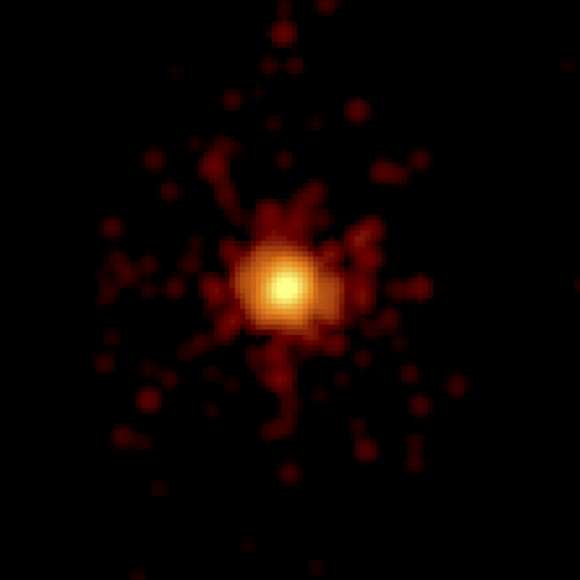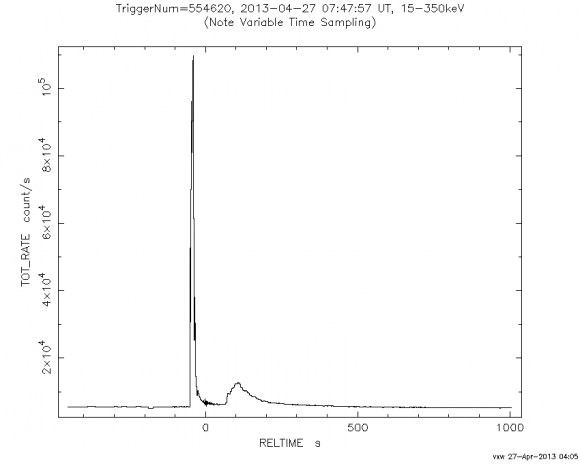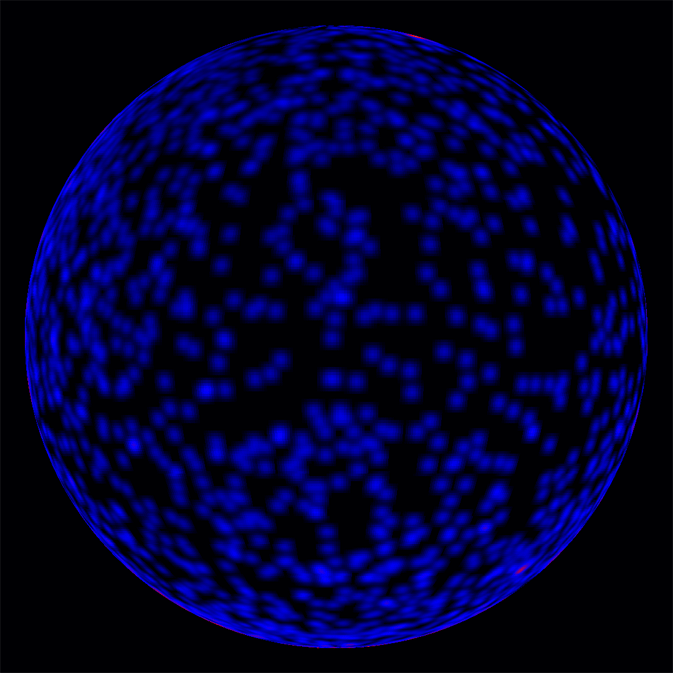Last weekend (April 27, 2013), the Fermi and Swift spacecraft witnessed a “shockingly” bright burst of gamma rays from a dying star. Named GRB 130427A, it produced one of the longest lasting and brightest GRBs ever detected.
Because Swift was able to rapidly determine the GRB’s position in the sky, and also because of the duration and brightness of the burst, the GRB was able to be detected in optical, infrared and radio wavelengths by ground-based observatories. Astronomers quickly learned that the GRB had one other near-record breaking quality: it was relatively close, as it took place just 3.6 billion light-years away.
“This GRB is in the closest 5 percent of bursts, so the big push now is to find an emerging supernova, which accompanies nearly all long GRBs at this distance,” said Neil Gehrels, principal investigator for Swift.

Credit: NASA/Swift/Stefan Immler.
“We have waited a long time for a gamma-ray burst this shockingly, eye-wateringly bright,” said Julie McEnery, project scientist for the Fermi Gamma-ray Space Telescope. “The GRB lasted so long that a record number of telescopes on the ground were able to catch it while space-based observations were still ongoing.”
No two GRBs are the same, but they are usually classified as either long or short depending on the burst’s duration. Long bursts are more common and last for between 2 seconds and several minutes; short bursts last less than 2 seconds, meaning the action can all over in only milliseconds.
This recent event started just after 3:47 a.m. EDT on April 27. Fermi’s Gamma-ray Burst Monitor (GBM) triggered on the eruption of high-energy light in the constellation Leo. The burst occurred as NASA’s Swift satellite was slewing between targets, which delayed its Burst Alert Telescope’s detection by a few seconds.
Fermi’s Large Area Telescope (LAT) recorded one gamma ray with an energy of at least 94 billion electron volts (GeV), or some 35 billion times the energy of visible light, and about three times greater than the LAT’s previous record. The GeV emission from the burst lasted for hours, and it remained detectable by the LAT for the better part of a day, setting a new record for the longest gamma-ray emission from a GRB.

As far as the optical brightness of this event, according to a note posted on the BAUT Forum (the Universe Today and Bad Astronomy forum) data from the SARA-North 1-meter telescope at at Kitt Peak in Arizona at about 04:00 UT on April 29 showed a relative magnitude of about 18.5.
Gamma-ray bursts are the universe’s most luminous explosions, and come from the explosion of massive stars or the collision between two pulsars. Colliding pulsars are usually of short duration, so astronomers can rule out a pulsar collision as causing this event.
If the GRB is near enough, astronomers usually discover a supernova at the site a week or so after the outburst.
NASA said that ground-based observatories are monitoring the location of GRB 130427A and expect to find an underlying supernova by midmonth.


“…just 3.6 billion light-years away…” That is a mind numbing distance to be a ‘just’? True, the furthest recorded was some 13 billion light years away, so your statement is therefore ‘justified’!
“…one gamma ray with an energy of at least 94 billion electron volts (GeV).” THAT would cook your potato!
“cook your potato”? I’m not so sure you’d have a potato left!
Just a euphemism…. ~@; )
Just a walk on the beach of the universe.
Just wondering, at what distance would something like this be dangerous to life on a planet such as earth?
I don’t know, but it is claimed that its progenitor event, a supernova, can have noticeable effects on Earth if closer than 3000 ly.
It is easier to estimate how much risk for the biosphere this contribute: no supernova or GRB (conventionally a supernova jet, a rare phenomena, aimed precisely at the solar system) has ever been conclusively tied to an extinction event.
Reversely, the Milky Way GRB frequency is believed to be ~ 0.1 to 1 million years at most, a minute percentage of which would be directed at Earth. [ http://en.wikipedia.org/wiki/Gamma-ray_burst ]
Either we have never been hit by a nearby GRB, or its effects is most often unnoticeable. Meaning the biosphere will most likely never be threatened by these in its remaining small lifetime (~ 10 % for complex multicellulars, ~ 30 % for cellulars).
Your very honest Tor. You don’t fully know. What I was told/taught back in my 1st yr in collage(when the Pope was just an alter-boy ..lol). The effects a SN has on life/earth is apprxm. 5000 ly.& not 3,000 ly. Maybe he was being liberal? I’d have to give you more advance knowledge in light of the years that have passed since the Professor taught of the effect of a SN distance on life/earth. Your should teach if your not already……take care.
These images are so amazing. I can’t imagine them
Thank you for the funny twist: “images” you can’t “imagine” 😉
The interesting part is that we really do not know what these are. They are considerably more energetic than supernova.
LC
Not true. It’s all a question of alignment, this is probably just pointed at us and most aren’t.
Too bad about Swift, but I hope there will be some neat astrophysics out of this anyway!
Could this of been created by a totally new phenom?